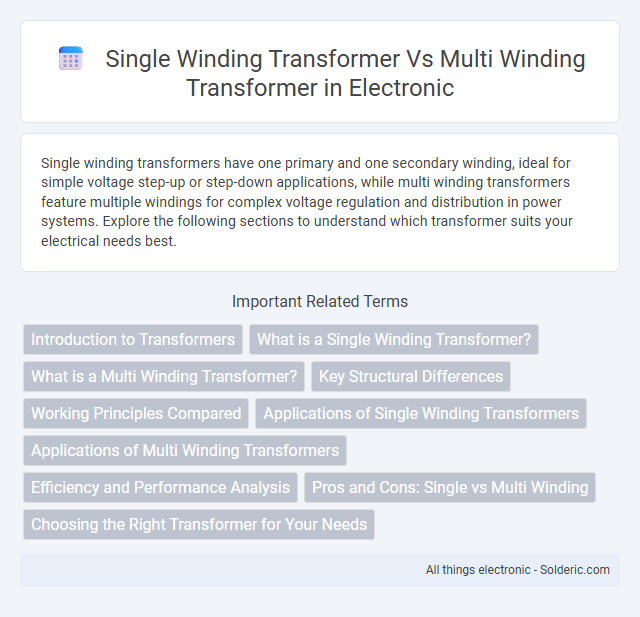Single winding transformers have one primary and one secondary winding, ideal for simple voltage step-up or step-down applications, while multi winding transformers feature multiple windings for complex voltage regulation and distribution in power systems. Explore the following sections to understand which transformer suits your electrical needs best.
Comparison Table
| Feature | Single Winding Transformer | Multi Winding Transformer |
|---|---|---|
| Number of Windings | One primary and one secondary winding | One primary winding and multiple secondary windings |
| Complexity | Simple design, easy to manufacture | More complex design and construction |
| Applications | Basic voltage step-up or step-down tasks | Multi-voltage output needs, isolation, and special functions |
| Cost | Generally lower cost | Higher cost due to additional windings |
| Flexibility | Limited output voltage options | Multiple secondary voltages from a single transformer |
| Size and Weight | Smaller and lighter | Larger and heavier due to multiple windings |
| Efficiency | High efficiency for single voltage output | May have slightly reduced efficiency due to additional windings |
| Isolation | Basic isolation between input and output | Enhanced isolation with separate secondary circuits |
Introduction to Transformers
Single winding transformers feature one primary and one secondary coil, offering simplicity and efficiency primarily for voltage step-up or step-down applications. Multi winding transformers contain multiple secondary coils, allowing simultaneous power distribution to different circuits or devices with varied voltage requirements. Understanding your power needs helps determine whether a single or multi winding transformer best suits your electrical system's demands.
What is a Single Winding Transformer?
A single winding transformer consists of only one coil that functions as either the primary or secondary winding, simplifying its design and application. It is commonly used in applications where voltage transformation is not necessary but isolation or signal coupling is required. Unlike multi winding transformers, single winding transformers have a straightforward construction that focuses on efficient energy transfer within a single coil configuration.
What is a Multi Winding Transformer?
A multi winding transformer features three or more windings on a single core designed to distribute electrical energy across multiple circuits at different voltage levels. Unlike single winding transformers, which have only primary and secondary coils, multi winding transformers handle complex power distribution tasks such as in power systems, medical equipment, and audio devices. Your choice of a multi winding transformer enhances flexibility by enabling simultaneous voltage transformations and isolation between circuits.
Key Structural Differences
Single winding transformers have one continuous coil that serves as both the primary and secondary winding, simplifying their design and reducing core losses. Multi winding transformers contain multiple coils wound on the same core, allowing them to handle multiple voltage levels or supply different circuits simultaneously. Your choice depends on the application requirements for voltage transformation flexibility and electrical isolation.
Working Principles Compared
A single winding transformer operates by transferring energy through electromagnetic induction between a primary and a secondary winding, typically designed for one specific voltage transformation. Multi winding transformers incorporate multiple secondary windings allowing simultaneous energy distribution across various voltage levels or circuits, enhancing versatility in complex electrical systems. Both types rely on mutual inductance principles but multi winding transformers facilitate multi-output applications without the need for separate transformers.
Applications of Single Winding Transformers
Single winding transformers are commonly used in applications where electrical isolation is not required, such as in autotransformers for voltage regulation and power distribution systems. They are ideal for stepping up or stepping down voltages in low-power devices, including audio equipment, lighting controls, and small appliances. Their design offers simplicity, compact size, and cost-effectiveness, making them suitable for industrial, commercial, and residential applications where efficiency and space are essential.
Applications of Multi Winding Transformers
Multi winding transformers are vital in power distribution systems, enabling voltage regulation across multiple circuits simultaneously. They are widely used in complex electrical networks, such as industrial plants and renewable energy systems, where multiple output voltages are required from a single transformer. Your electrical setup benefits from enhanced flexibility and efficiency when incorporating multi winding transformers for diverse load requirements.
Efficiency and Performance Analysis
Single winding transformers typically offer higher efficiency due to reduced core losses and simpler magnetic flux paths, making them ideal for applications requiring minimal energy loss. Multi winding transformers provide greater flexibility and functionality by supplying multiple voltage levels or circuits but often sacrifice some efficiency because of increased leakage inductance and complex magnetic interactions. Your choice between these transformer types should balance the need for performance precision against efficiency priorities in your specific electrical system.
Pros and Cons: Single vs Multi Winding
Single winding transformers offer simplicity and reduced manufacturing costs, making them ideal for straightforward voltage conversion tasks with minimal core losses. Multi winding transformers provide greater versatility by enabling multiple voltage levels and isolation points, supporting complex electrical systems and reducing the need for multiple transformers. However, multi winding designs can be more expensive, larger, and more susceptible to inter-winding capacitance issues, which may affect performance in high-frequency applications.
Choosing the Right Transformer for Your Needs
Single winding transformers provide straightforward voltage transformation with simplicity and cost-effectiveness, ideal for basic applications requiring a single output voltage. Multi winding transformers offer versatile voltage outputs and improved efficiency, suitable for complex systems needing multiple voltages or isolation between circuits. You should evaluate your power requirements, space constraints, and circuit complexity to choose the right transformer that optimizes performance and reliability.
single winding transformer vs multi winding transformer Infographic

 solderic.com
solderic.com